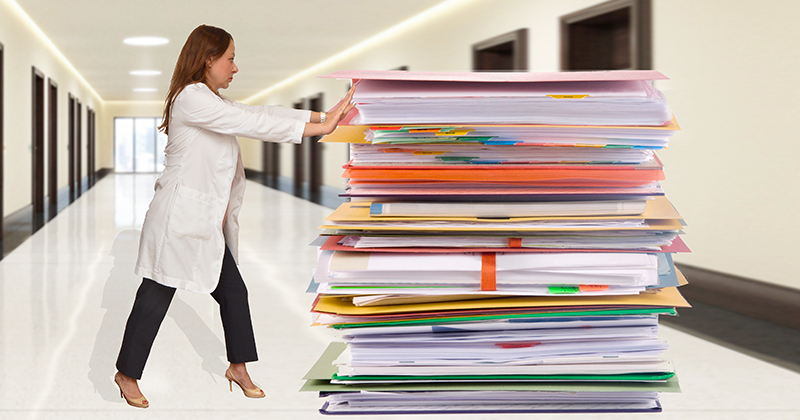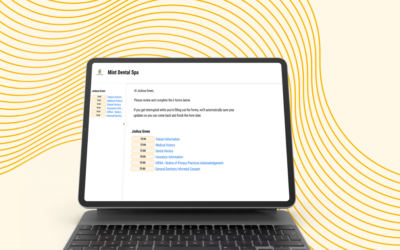
This article has a read time of 4 minutes and 30 seconds.
Is your dental practice straddling the fence when it comes to technology? Have you gone chartless with your patient records, but your front office employees still scan handwritten patient forms and manually enter information into your practice management software, while patients wait to be seated? Or do you use a powerful practice management software, such as Dentrix, Eaglesoft, and Open Dental but still hold on to your paper charts because you believe that paper is cheap? If so, it is time for you to make the switch to a completely paperless dental office.
Technology has changed the way we practice dentistry today. Not only we can leverage technology to diagnose and treat patients more effectively, but we can utilize technology to run our dental practices more efficiently. With a paperless office, we can streamline our operations, saving both time and money.
Of course, switching to a paperless system takes an initial investment of time for you and your team to learn the new technology and of money to purchase the necessary hardware and software. However, these investments will more than pay off in a short amount of time. Let’s see how.
Paper charts are costing you money.
As an example, let’s use a hypothetical practice with one dentist and two hygienists. This practice sees about 500 new patients each year and has 3,000 active patients. On an initial visit, each patient completes new patient forms, including patient information, medical history, and HIPAA paperwork and signs financial and treatment consent forms.
On a return visit, the patient typically signs more forms, including treatment consent forms and medical history updates – often adding up to another five pages of documents per patient every year. Additionally, each patient chart contains administrative notes, progress notes, and other hand-written paperwork.
Now, consider that storing these 3,000 paper charts requires filing supplies, cabinets and a significant amount of office floor space.
The estimated cost of supplies for each new chart is a minimum of $6 – including the file folder (50 cents to $1); patient registration, medical history, exam, progress notes and administrative notes (20 cents per page); and chart label (50cents). Therefore, the cost of these 3,000 paper charts is about $18,000 with an ongoing cost of $1000 a year for new patients. And every time a patient returns for a follow-up visit, there is more paper to complete and file away. These additional 20,000 pieces of paper add another $1600 or more per year to the cost of running an office with paper files.
However, the most significant expense of running a dental practice with paper files is your team’s time. A team member must put the chart together in the first place, pull it every time a patient calls or visits the practice, add new forms and then refile it. When you factor in the potentially wasted time searching for misfiled or lost charts, your staff spends at least 10 minutes of time per patient per year. That conservative estimate adds up to 500 staff hours each year! Let’s look at it another way. If your staff member earns $20 per hour, you are paying that person $10,000 per year just to file charts. Now, these figures don’t even include the time it takes your team to manually enter individual patient information into the computer on a first office visit (an estimated 10 minutes) or when a medical history update is needed (about five minutes). These tasks add up to more than 300 hours each year or $6,000 in salary.
And, keep in mind that paper charts of inactive patients continue to take up valuable space in your office since they must be stored for many years.
When you add up all these estimated figures – including the initial investment of 18,000 and an ongoing expense of at least $18,600 annually – you can clearly see that paper charts are very costly to maintain.
But I am already paperless!
I hear this from many dentists and dental teams. Often, when they say “paperless, ” they mean “chartless.” Let’s clarify the distinction between a chartless office and a paperless one. These two terms are often used interchangeably, but there is a significant difference.
The term “chartless” refers to how we store patient information while “paperless” refers to how we receive and retrieve that information. Let’s examine the distinction further.
If you have a chartless office, you have replaced your paper charts with electronic records; however, your patients still fill out paper forms (including personal information, medical history, consent forms, and financial documents). Your employees then enter this data into your computer system, before scanning and shredding the paper forms.
With a paperless office, however, the time-consuming and redundant paper stage is bypassed entirely. Patients complete and sign forms on an iPad in your office or on your website from their home computers or mobile devices. The information is immediately sent to your practice where your team can view and upload this information into your practice management software with just a few clicks.
If your office is chartless but not paperless, your hybrid chartless system is very costly. If you use electronic dental records, chances are that you have already invested in a robust computer system and equipment. Yet, you still spend a lot of money on paper forms and toner and your staff is still wasting valuable time. In a typical practice, such as the one we are using as an example, staff members spend about 600 hours each year manually entering patient data into your software, not including hundreds of hours scanning and shredding paper.
Also, a chartless office is filled with redundant tasks that take up time but don’t add anything to the quality of care that patients receive. Patients fill out paperwork and then must wait while a team member enters their information into the computer and scans and shreds the hand-written forms. And once the forms are scanned, the clinical team now needs to sift through scanned forms and different parts of the practice management software to find relevant information. Besides being time-consuming and tedious, data entry and scanning, just like filing, are prone to errors. Your employee could accidentally scan a form into the wrong chart or make a mistake due to illegible handwriting.
When looking at the numbers, it becomes clear that a truly paperless office is the most efficient and economical way to run a dental practice today. Your team will save time on data entry, scanning, and filing. You will save money on supplies and storage. And your patients won’t have to wait while your team is busy managing paper.
Most importantly, you will be able to devote those valuable resources to what truly matters – taking care of your patients and growing your dental practice.



